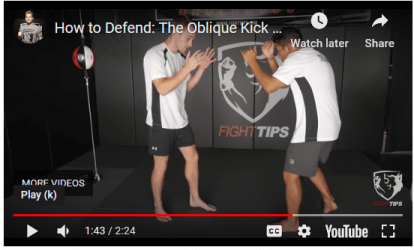- Joined
- Aug 3, 2015
- Messages
- 14,100
- Reaction score
- 6,015
I was looking for a picture of a low kick for a different post and came across this video. This is defense against the "Oblique kick" and the defenses here are garbage.
1. The kick is extremely quick and it usually happens in a moments notice. There's no wind up to it.
2. Unlike other kicks, this kick works because the attacker is waiting for you to be in the worst possible position to defend against it, which is usually bearing weight on the lead leg.
3. This is a high success rate technique. The only reason it doesn't work is because the person doing it sucks at it.
4. This kick targets the rooting leg, So trying to leg check it is just going to make me go after that nice one leg stance
The kick doesn't always have to "stomp down" an a person's leg. I shoot my kick out horizontally to strike the shins.Which causes internal damage to the calf muscle.as the shock from the kick literally bounces the muscle away from the bone.and then slams the muscle back into the bone. (I learned this the hard way).
These defenses do not and will not work against someone who knows how to use this kick.
This stuff reminds me of some Kung Fu stuff where the guys make assumptions about defending against a strike and just say, "yeah all you have to do, is do this" and it's never based on the experience of having to deal with that particular strike.
Lesson to learn: Do do this stuff if you are trying to defend against that type of kick. You'll lose every time if the person is good and you'll put yourself in more danger
1. The kick is extremely quick and it usually happens in a moments notice. There's no wind up to it.
2. Unlike other kicks, this kick works because the attacker is waiting for you to be in the worst possible position to defend against it, which is usually bearing weight on the lead leg.
3. This is a high success rate technique. The only reason it doesn't work is because the person doing it sucks at it.
4. This kick targets the rooting leg, So trying to leg check it is just going to make me go after that nice one leg stance
The kick doesn't always have to "stomp down" an a person's leg. I shoot my kick out horizontally to strike the shins.Which causes internal damage to the calf muscle.as the shock from the kick literally bounces the muscle away from the bone.and then slams the muscle back into the bone. (I learned this the hard way).
These defenses do not and will not work against someone who knows how to use this kick.
This stuff reminds me of some Kung Fu stuff where the guys make assumptions about defending against a strike and just say, "yeah all you have to do, is do this" and it's never based on the experience of having to deal with that particular strike.
Lesson to learn: Do do this stuff if you are trying to defend against that type of kick. You'll lose every time if the person is good and you'll put yourself in more danger

